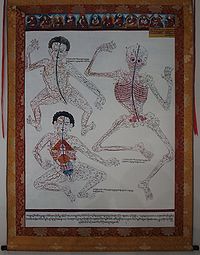
Back བོད་སྨན། Tibetan Medicina tradicional tibetana Catalan Tibetische Medizin German Tibeta medicino Esperanto Medicina tradicional tibetana Spanish Tiibeti meditsiin Estonian Médecine traditionnelle tibétaine French सोवा रिग्पा Hindi チベット医学 Japanese ტრადიციული ტიბეტური მედიცინა Georgian

| This article is part of a series on |
| Alternative medicine |
|---|
 |
Traditional Tibetan medicine (Tibetan: བོད་ཀྱི་གསོ་བ་རིག་པ་, Wylie: bod kyi gso ba rig pa), also known as Sowa-Rigpa medicine, is a centuries-old traditional medical system that employs a complex approach to diagnosis, incorporating techniques such as pulse analysis and urinalysis, and utilizes behavior and dietary modification, medicines composed of natural materials (e.g., herbs and minerals) and physical therapies (e.g. Tibetan acupuncture, moxabustion, etc.) to treat illness.
The Tibetan medical system is based upon Indian Buddhist literature (for example Abhidharma and Vajrayana tantras) and Ayurveda.[1]In addition to the Tibetan areas of China, the areas in which Tibetan medicine has spread include the Ladakh and Sikkim regions of northern India, the western and northern parts of Nepal and the entire territory of Bhutan. China's Inner Mongolia, Xinjiang and the Mongolian-populated areas in the northeast have historically been greatly influenced by Tibetan medicine. The traditional medicine of Mongolia and the Buryat and Tuva regions of the Russian Federation, as well as the Republic of Kalmykia, located in the Volga River basin, is also predominantly Tibetan medicine. It embraces the traditional Buddhist belief that all illness ultimately results from the three poisons: delusion, greed and aversion. Tibetan medicine follows the Buddha's Four Noble Truths which apply medical diagnostic logic to suffering.[2][3] The use of the caterpillar fungus (Ophiocordyceps sinensis), a world-famous medicinal and economic fungus, originates in Tibetan medicine.[4]
- ^ Garrett, Frances (2008). Religion, Medicine and the Human Embryo in Tibet. Routledge. pp. 23–32.
- ^ Gyamtso, Sangye (April 2005). "Intro card". Tibetan Medicine Cards: Illustrations and Text from the Blue Beryl Treatise of Sangye Gyamtso (1653-1705). Pomegranate Communications. p. 32. ISBN 978-0764917615.
- ^ Kala, C.P. (2005) Health traditions of Buddhist community and role of amchis in trans-Himalayan region of India. Current Science, 89 (8): 1331-1338.
- ^ Lu, D. (2023). The Global Circulation of Chinese Materia Medica, 1700-1949: A Microhistory of the Caterpillar Fungus. Medicine and Biomedical Sciences in Modern History. Palgrave Macmillan. pp. 1–294. doi:10.1007/978-3-031-24723-1. ISBN 978-3-031-24722-4. S2CID 256618310.
© MMXXIII Rich X Search. We shall prevail. All rights reserved. Rich X Search